28 Mar

While advertising attribution has always been a thorny path for marketers to navigate, events of the past 18 months have caused a significant upheaval in media measurement that must be addressed quickly – for the sake of all parties involved.
It’s convenient to blame the collapse in advertising measurement on policy changes made by Apple and Google, but social media platforms have always used flawed last-touch attribution to report on campaign performance. By counting every conversion an ad was in the path of, platforms ignored the fact that some of those events would have happened anyway.
Before iOS 14.5 and ATT, incrementality testing consistently proved many platforms were overreporting conversions, but it was mostly ignored because last-touch metrics made them look good. The amount of extra credit could vary widely by audience type – think prospecting (mild) vs. retargeting (heavy). Advertisers were either unaware of the inaccuracies, or turned a blind eye because it made them look good too.
Now, due to increasing data privacy restrictions, social media platforms are losing the ability to track conversions for a significant segment of users, causing them to begin underreporting conversions using that same broken last-touch system of measurement.
Many organizations are working to solve for the loss of visibility through ID alternatives or revamped attribution modeling but these approaches – challenged with effectiveness and lingering privacy concerns – could be years off from becoming a reality. Advertisers need relief right now.
Incrementality testing can prove the value of ad campaigns on social media platforms, even when their own measurement systems cannot. Regardless of how dire the prognosis for cookies becomes, incrementality measurement will continue to be effective – and it already exists.
Anchored on first-party data and cohort-based analytics, incrementality measurement is unaffected by inevitable policy changes because it doesn’t require tracking at the user-level to produce reliable results. Independent of platform bias and rooted in proven experiment methodology, testing for incrementality can provide ongoing insight at a tactical level so advertisers can continuously move dollars to where they drive the greatest business impact.
We work with 100+ DTC brands, and every single one of them has some level of media budget being invested into Facebook. Some advertisers we work with are using incrementality testing to justify continued or increased investment in Facebook, knowing their campaigns are performing better than Facebook attribution would lead them to believe. For luxury brand Shinola, incrementality experiments recently revealed Facebook was underreporting performance of prospecting campaigns by 413%.
Other brands want to diversify away from steadily rising Facebook ad costs and are using incrementality experiments to test and scale into new channels like TikTok, Snap, Pinterest, or CTV. With incrementality and geo testing, marketers can spend a small fraction of budget to understand how pushing into new channels will pay off.
While decisions by Apple, Google and others can and do have a significant impact on the media industry (and all the businesses that operate within it), when it comes to platform attribution, they have simply exposed a broken system of self-reporting that never should have been acceptable in the first place.
Incrementality testing and experimentation can finally put to bed a decades-long struggle, for platforms and marketers alike, to become the standard advertising measurement approach that is useful, lasting and acceptable for everyone involved.
Read the new guide, Incrementality Measurement for DTC Marketers, to learn how incrementality testing works and how to set up your own experimentation practice today.
Source: www.socialmediatoday.com, originally published on 2022-03-28 04:00:00
Connect with B2 Web Studios
Get B2 news, tips and the latest trends on web, mobile and digital marketing
- Appleton/Green Bay (HQ): (920) 358-0305
- Las Vegas, NV (Satellite): (702) 659-7809
- Email Us: [email protected]

© Copyright 2002 – 2022 B2 Web Studios, a division of B2 Computing LLC. All rights reserved. All logos trademarks of their respective owners. Privacy Policy

![How to Successfully Use Social Media: A Small Business Guide for Beginners [Infographic]](https://b2webstudios.com/storage/2023/02/How-to-Successfully-Use-Social-Media-A-Small-Business-Guide-85x70.jpg)



![How to Successfully Use Social Media: A Small Business Guide for Beginners [Infographic]](https://b2webstudios.com/storage/2023/02/How-to-Successfully-Use-Social-Media-A-Small-Business-Guide-300x169.jpg)


Recent Comments